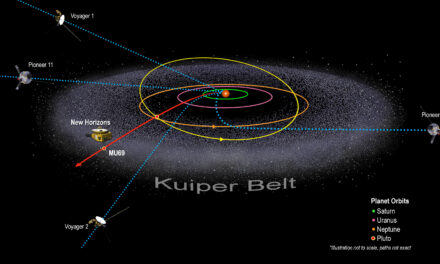Pluto, once considered the ninth planet of our solar system, was reclassified as a dwarf planet by the International Astronomical Union (IAU) in 2006. This decision sparked debates and discussions among scientists and the general public alike. One of the key factors influencing Pluto’s reclassification was its size and mass. In this article, we will delve into the significance of these characteristics in understanding why Pluto is now recognized as a dwarf planet.
Pluto’s Size
Pluto’s size played a pivotal role in its reclassification. Previously, the definition of a planet was loosely based on the assumption that planets were large celestial bodies that orbit the Sun and have cleared their orbits of other debris. However, Pluto’s discovery in 1930 opened up a new understanding of our solar system, challenging this definition. Pluto has a diameter of approximately 2,376 kilometers (1,476 miles), making it significantly smaller than any of the other eight planets in our solar system. For comparison, Earth’s diameter is around 12,742 kilometers (7,918 miles). Its relatively small size raised questions about whether it should be classified as a full-fledged planet or as something else.Mass and Gravitational Influence
Another crucial aspect of Pluto’s reclassification is its mass and gravitational influence. Although Pluto is smaller in size compared to other planets, it still possesses a considerable mass. However, its mass is much smaller than that of the eight recognized planets. The IAU’s definition of a planet includes a requirement that a planet must dominate its orbit and gravitationally influence its surroundings. Pluto’s gravitational influence is much weaker compared to the eight planets, primarily due to its smaller mass. Its orbit also intersects with Neptune’s, which further raises questions about its status as a planet.Discovery of Trans-Neptunian Objects
The discovery of numerous other objects beyond Pluto, known as trans-Neptunian objects (TNOs), also influenced the reclassification. TNOs are similar in size and composition to Pluto and are located in the Kuiper Belt, a region of the outer solar system. The existence of TNOs challenged the notion that Pluto was a unique planet, prompting the IAU to reassess its classification. Instead, the IAU introduced a new category of celestial objects known as dwarf planets, including Pluto, Eris, Haumea, Makemake, and Ceres, which meet specific criteria but do not fully qualify as traditional planets.Conclusion
Pluto’s reclassification as a dwarf planet was influenced by several factors, with its size and mass playing a crucial role. Its smaller size compared to the eight recognized planets, combined with its weaker gravitational influence, led to the conclusion that Pluto did not meet the updated criteria for a full-fledged planet. Additionally, the discovery of other objects in the outer solar system, similar to Pluto, shed light on the need for a revised classification system. This resulted in the creation of the category of dwarf planets, which recognizes celestial objects that share characteristics with planets but do not fulfill all the requirements. While the debate surrounding Pluto’s classification continues, the reclassification has deepened our understanding of the diversity and complexity of objects in our solar system. It highlights the importance of continually refining scientific definitions and classifications to accommodate new discoveries and promote a more comprehensive understanding of the universe we inhabit.References
- International Astronomical Union (IAU)
- NASA – The Solar System Exploration: Planets
- Brown, M. E., & Butler, B. J. (2018). The Dwarf Planets. In The New Solar System (5th ed., pp. 213-235). Cambridge University Press.










